Fire Safety Services Market
Fire Safety Services Market Size and Share Forecast Outlook 2025 to 2035
Fire safety services market is projected to grow from USD 155.5 billion in 2025 to USD 232.5 billion by 2035, at a CAGR of 4.1%. Fire Alarm Monitoring will dominate with a 42.0% market share, while commercial will lead the end user segment with a 50.0% share.
Fire Safety Services Market Forecast and Outlook 2025 to 2035
The global fire safety services market is valued at USD 155.5 billion in 2025. The market is slated to reach USD 232.5 billion by 2035. This records an absolute increase of USD 77.0 billion over the forecast period. The total growth amounts to 49.5%. The market forecast shows expansion at a compound annual growth rate (CAGR) of 4.1% between 2025 and 2035.
The overall market size is expected to grow by approximately 1.50X during the same period. Growth is supported by increasing building safety regulations. Growing commercial construction drives expansion. Expanding fire protection awareness supports market development. Rising insurance requirements occur across property sectors.
Quick Stats for Fire Safety Services Market
- Fire Safety Services Market Value (2025): USD 155.5 billion
- Fire Safety Services Market Forecast Value (2035): USD 232.5 billion
- Fire Safety Services Market Forecast CAGR: 4.1%
- Leading Service Type in Fire Safety Services Market: Fire alarm monitoring (42.0%)
- Key Growth Regions in Fire Safety Services Market: North America, Europe, and Asia-Pacific
- Key Players in Fire Safety Services Market: Johnson Controls, Honeywell, Siemens, UTC Climate, Allegion, Tyco, Schneider Electric, Chubb, Securitas, ADT
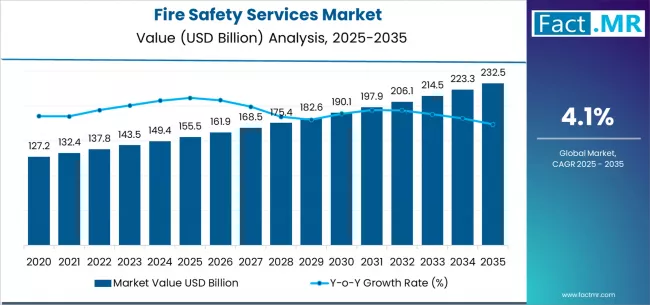
The fire safety services market represents a specialized segment of the global building services industry. The market shows steady technological advancement. Consistent demand exists across building safety channels. Commercial protection channels drive growth. Market dynamics are influenced by changing regulatory requirements toward comprehensive fire protection.
Growing interest in life safety management shapes development. Expanding partnerships between safety service providers drive growth. Building operators in developed economies show increased adoption. Emerging economies demonstrate growing demand patterns. Traditional safety methods continue evolving. Safety managers seek proven protection alternatives. Enhanced life safety benefits attract property users. Reliable performance characteristics remain essential requirements.
Consumer behavior in the fire safety services market reflects broader building automation trends. Efficient protection systems provide functional benefits. Effective systems deliver life safety assurance. The market benefits from growing popularity of integrated safety solutions. These systems are recognized for sophisticated regulatory integration.
Technical approach to fire protection gains acceptance. The versatility of fire safety services supports multiple applications. Standalone safety devices serve specific needs. Integrated building system components expand market reach. Multiple property applications drive demand growth. Commercial segments show increased adoption patterns.
Regional adoption patterns vary significantly across global markets. North American markets show strong preference for standardized fire safety implementations. European markets demonstrate similar standardization trends. Asian markets show increasing adoption of advanced safety solutions.
Conventional protection systems remain popular in developing regions. The building landscape continues evolving with sophisticated products. Quality-controlled fire safety products gain traction in mainstream applications. Building applications reflect operator willingness to invest in improvements. Proven safety system enhancements attract investment. Performance-oriented features drive adoption decisions.
The competitive environment features established building services companies. Specialized fire safety solution providers focus on unique capabilities. Advanced detection methods drive differentiation. Service efficiency remains critical for market participants. Product development optimization continues as key factor. Equipment costs create ongoing challenges. Quality standardization requirements fluctuate regularly. Distribution strategies emphasize multi-channel approaches. Traditional building supply chains combine with direct partnerships. Technical service platforms expand market reach. Service distribution agreements strengthen customer relationships.
Market consolidation trends indicate acquisition strategies by larger manufacturers. Building services manufacturers acquire specialized fire safety companies. Service portfolio diversification drives acquisition activity. Access to specialized safety system segments motivates purchases. Private label development has gained momentum. Building companies seek differentiation opportunities.
Competitive pricing structures remain important considerations. Specialized fire safety variants emerge in the market. Smart-enabled options reflect changing building priorities. IoT-integrated options create new market opportunities. Innovative safety system developers benefit from emerging trends. Service automation enables consistent delivery scaling. Quality control improvements maintain traditional performance characteristics. Building managers expect established performance from safety system brands.
Between 2025 and 2030, the fire safety services market projects expansion from USD 155.5 billion to USD 194.0 billion. This results in a value increase of USD 38.5 billion. The increase represents 50.0% of the total forecast growth for the decade. This development phase will be shaped by increasing adoption of building automation systems.
Rising demand for integrated safety solutions drives growth. Smart building technologies gain market acceptance. Growing emphasis on life safety characteristics supports expansion. Enhanced monitoring capabilities attract users. Building operators expand safety capabilities. Growing demand for specialized fire safety implementations continues. Advanced detection options gain popularity. Service offerings across property segments increase.
Fire Safety Services Market Key Takeaways
| Metric | Value |
|---|---|
| Estimated Value (2025E) | USD 155.5 billion |
| Forecast Value (2035F) | USD 232.5 billion |
| Forecast CAGR (2025-2035) | 4.10% |
From 2030 to 2035, the market is forecast to grow from USD 194.0 billion to USD 232.5 billion. This adds another USD 38.5 billion. The addition constitutes 50.0% of the overall ten-year expansion. This period is expected to be characterized by expansion of smart protection systems. Integration of IoT-enabled solutions continues. Development of specialized fire safety implementations occurs.
Enhanced intelligence profiles gain importance. Extended monitoring capabilities attract users. Growing adoption of AI-powered systems will drive demand. Fire safety services with superior detection characteristics gains acceptance. Compatibility with smart building technologies across property operations expands.
Between 2020 and 2025, the fire safety services market experienced steady recovery. Post-pandemic building reopening drove development. Growing recognition of fire safety services as essential building systems supported expansion. Life safety programs across commercial properties gained momentum. Industrial applications showed growth.
The market developed as building operators recognized potential benefits. Fire safety solutions provide functional advantages. Superior protection capabilities enable convenient building protocols. Technological advancement in safety systems began development. Safety-critical applications emphasize importance of maintaining performance. Consistency in diverse building environments becomes critical.
Why is the Fire Safety Services Market Growing?
Market expansion is supported by increasing building safety regulations. Fire protection requirements drive growth. Life safety compliance needs create demand. Corresponding need for safety services provides superior protection benefits. Building advantages enable enhanced safety outcomes. Extended compatibility across various property applications drives growth. Industrial applications show expansion.
Modern building operators focus on implementing proven safety solutions. Protection specialists seek effective life safety support. Minimized regulatory complexity appeals to users. Consistent performance throughout complex building configurations attracts adoption. Diverse property environments require reliable solutions.
Fire safety services deliver exceptional protection efficacy against traditional alternatives. Advanced building integration capabilities support modern protocols. Essential components for contemporary property operations gain acceptance.
Growing emphasis on building codes drives demand for comprehensive safety adoption. Fire safety services support large-scale building requirements. Improved protection outcomes attract users. Advanced safety systems gain acceptance. Building manager preference for products combines effective protection support with proven performance.
Regulatory benefits create opportunities for innovative implementations. Rising influence of smart building trends contributes to increased demand. Safety awareness drives market growth. Fire safety services provide advanced reliability. Seamless building integration appeals to users. Consistent performance across extended operation periods remains important.
Opportunity Pathways - Fire Safety Services Market
The fire safety services market shows potential for steady growth. Technological advancement continues development. Building operators across North America seek services delivering exceptional safety quality. Europe shows similar trends. Asia-Pacific markets demonstrate growth potential. Emerging markets seek advanced protection capabilities. Reliable monitoring options gain acceptance. Fire safety solutions gain prominence beyond building services. Strategic enablers of building automation expand applications. Advanced safety functionality grows in importance.
Rising building automation adoption in Asia-Pacific amplifies demand. Expanding fire protection initiatives globally support growth. Service providers leverage innovations in safety engineering. Advanced building integration gains momentum. Safety management technologies advance rapidly.
Pathways like high-performance implementations show promise for strong margin uplift. Specialized safety platforms demonstrate potential. Advanced protection solutions target premium building segments. Geographic expansion captures volume opportunities. Service diversification addresses market needs. Local building preferences become critical factors. Advanced safety adoption drives regional growth. Regulatory support around fire codes provides structural foundation. Safety efficacy standards gain importance. Protection protocols strengthen market development.
- Pathway A - Smart Building Implementations. Commercial operators require fire safety services with high-performance capabilities. Large buildings demand advanced monitoring profiles for enhanced safety appeal. Premium positioning capabilities attract investment. Safety system developers creating high-performance platforms with superior protection standards command premium pricing. Expected revenue pool: USD 46.7 billion to USD 58.1 billion.
- Pathway B - Specialized Monitoring Platforms. Growing demand for specialized safety implementations drives market growth. Advanced protection capabilities attract users. Unique detection features create demand for advanced building capabilities. Specialized property integration opportunities exist. Revenue opportunity: USD 38.9 billion to USD 48.4 billion.
- Pathway C - Advanced Detection Solutions. Advanced fire safety formulations meet specific building requirements. Safety compatibility requirements grow. Specialized protection profiles enable market expansion. Enhanced operator appeal attracts safety-focused building managers. Revenue lift: USD 31.1 billion to USD 38.6 billion.
- Pathway D - Industrial Applications. Expanding reach into industrial platforms creates opportunities. Optimized safety delivery gains importance. Advanced building integration capabilities expand. Extended protection capabilities attract users. Operators seek partners supplying integrated solutions with complete safety functionality. Pool: USD 34.4 billion to USD 42.8 billion.
- Pathway E - Geographic Expansion & Local Services. Strong growth in APAC markets continues. China shows particular potential. India demonstrates expansion opportunities. Southeast Asia markets develop rapidly. Local services lower costs. Service complexity reduction enables faster response to regional preferences. Expected upside: USD 37.8 billion to USD 47.0 billion.
- Pathway F - Residential Market Development. Increasing demand for residential formulations grows. Home safety functionality gains importance. Specialized protection profiles with validated performance characteristics attract property developers. Revenue opportunity: USD 23.3 billion to USD 29.0 billion.
- Pathway G - IoT Integration Services. Developing comprehensive smart solutions creates differentiation. Digital platform compatibility services expand applications. Safety programs address specialized requirements for building operators. Property companies show growing demand from intelligent safety services. Pool: USD 21.0 billion to USD 26.1 billion.
Segmental Analysis
The market is segmented by service type, end user, and region. By service type, the market divides into fire alarm monitoring, sprinkler installation, and inspection & maintenance categories. By end user, it covers commercial, industrial, and residential segments. Regionally, the market spans North America, Europe, and Asia-Pacific as primary regions.
Why Does the Fire Alarm Monitoring Segment Lead the Market?
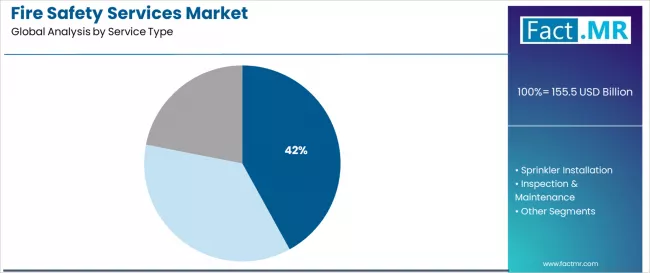
The fire alarm monitoring segment projects to account for 42.0% of the fire safety services market in 2025. This reaffirms its position as the leading service category. Building operators utilize monitoring implementations for superior detection standards. Safety system integrators prefer these services when operating across diverse property platforms.
Alarm-based fire monitoring systems are more reliable. There is widespread acceptance ranging from basic monitoring operations to critical building safety. Fire alarm monitoring technology's advanced detection methods address operator requirements for efficient safety solutions. Complex building environments benefit from these capabilities.
This service segment forms the foundation of modern building safety adoption patterns. The implementation offers greatest operational reliability. Established market demand exists across multiple property categories. Safety segments show strong adoption. Operator investments in monitoring standardization continue.
Safety efficiency improvements strengthen adoption among building producers. Property companies prioritize reliability with operational efficiency. Fire alarm monitoring implementations align with functionality preferences. Performance expectations make these services central components of comprehensive building safety strategies.
What Makes the Commercial Segment a Major End User in the Market?
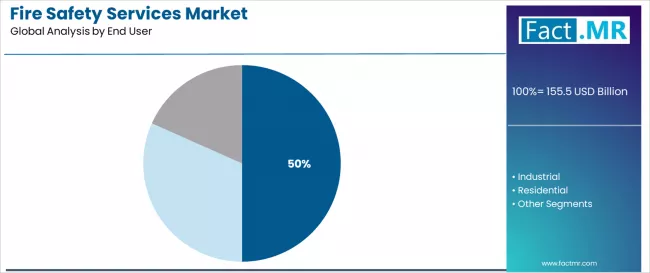
The commercial applications project to represent 50.0% of fire safety services demand in 2025. This underscores their critical role as primary deployment sector for safety systems. Office operations benefit from comprehensive advantages. Retail facilities show strong adoption.
Commercial operators utilize fire safety services for exceptional protection characteristics. Proven reliability in high-occupancy environments attracts users. Ability to maintain consistent safety performance across diverse commercial conditions appeals to building managers. The segment's dominance reflects critical nature of life safety in commercial operations. Industry commitment to tenant safety standards drives adoption.
The commercial sector drives innovation in safety technology through demanding occupancy requirements. Stringent building regulations exist. Operators invest heavily in advanced safety systems ensuring operational continuity.
Code compliance requirements grow. Increasing emphasis on tenant safety supports market position. Life safety management initiatives expand. Commercial applications maintain position as largest end-user segment. Technological advancement initiatives continue. Performance optimization across fire safety markets gains momentum.
What are the Drivers, Restraints, and Key Trends of the Fire Safety Services Market?
The fire safety services market advances steadily due to increasing building safety regulations driven by fire code enforcement. Growing commercial construction requirements support expansion. Growing adoption of safety systems provides superior protection characteristics. Life safety benefits enable enhanced building outcomes across diverse property applications. Industrial applications expand market reach.
The market faces challenges including service cost pressures. Complex regulatory requirements create compliance needs. Specialized building requirements grow. Safety programs become more sophisticated. Innovation in smart technologies continues influencing service development. IoT integration methods drive market expansion patterns.
Expansion of Smart Building Technologies and Safety Solution Integration
Growing adoption of building solutions enables market development. Advanced building management capabilities expand applications. Property automation awareness drives service providers to produce advanced fire safety solutions. Superior protection positioning attracts users. Enhanced reliability profiles gain acceptance. Seamless integration functionalities expand market reach.
Advanced safety systems provide improved operational outcomes. More efficient building workflows develop. Reliable performance across various property applications continues. Operating conditions improve with advanced systems. Developers recognize competitive advantages of safety solution integration capabilities. Market differentiation opportunities expand. Protection positioning becomes increasingly important.
Integration of Advanced Monitoring Methods and Detection Engineering
Modern fire safety providers incorporate advanced monitoring technology. Building system integration expands capabilities. Sophisticated safety solutions enhance service appeal. Intelligent detection features develop rapidly. Value-added solutions for building customers gain acceptance. These technologies improve safety efficiency. New market opportunities emerge including standardized performance.
Optimized protection enhancement capabilities expand. Enhanced reliability characteristics attract users. Advanced building integration allows developers supporting comprehensive property technologies. Market expansion beyond traditional safety approaches continues.
Development of Commercial Construction and Building Safety Integration
Growing adoption of construction solutions enables market development. Advanced building management capabilities expand applications. Construction safety awareness drives service providers to produce advanced fire safety solutions. Superior building positioning attracts users. Enhanced safety profiles gain acceptance. Seamless integration functionalities expand market reach.
Advanced safety systems provide improved construction outcomes. More efficient building workflows develop. Reliable performance across various construction applications continues. Building conditions improve with advanced systems. Developers recognize competitive advantages of construction solution integration capabilities. Market differentiation opportunities expand. Building positioning becomes increasingly important.
How will Fire Safety Services Deployment Vary by Key Countries?

| Country | CAGR (2025-2035) |
|---|---|
| USA | 5.0% |
| Mexico | 4.7% |
| Germany | 4.5% |
| France | 4.2% |
| UK | 4.1% |
| South Korea | 4.0% |
| Japan | 3.8% |
The global fire safety services industry continues to witness steady expansion, supported by heightened safety regulations, modernization initiatives, and rising investments in fire protection infrastructure. The USA leads the global landscape, projected to register a CAGR of 5.0% through 2035, driven by expanding commercial construction and increasing implementation of building safety programs.
Continuous investment in advanced fire protection systems further reinforces market growth. Mexico follows with a 4.7% CAGR, propelled by robust construction activity, safety modernization efforts, and the expansion of commercial infrastructure.
Germany maintains a 4.5% growth rate, supported by its engineering excellence and ongoing advancements in safety technologies. France, growing at 4.2%, benefits from expanding building capabilities and continued integration of modern fire safety systems. The UK is projected to grow at 4.1%, with innovation in safety technologies expected to be a key enabler of long-term development.
South Korea demonstrates a 4.0% CAGR, driven by rapid safety technology innovation and sustained building advancement, while Japan, with 3.8% growth, continues to emphasize quality control initiatives and technology-oriented construction practices. Overall, rising adoption of building innovation and advanced safety technologies remains central to the market’s global growth trajectory.
The report covers in-depth analysis of 40+ countries. Seven top-performing countries receive highlighting below.
How Is the USA Advancing Global Leadership in Building Fire Safety?
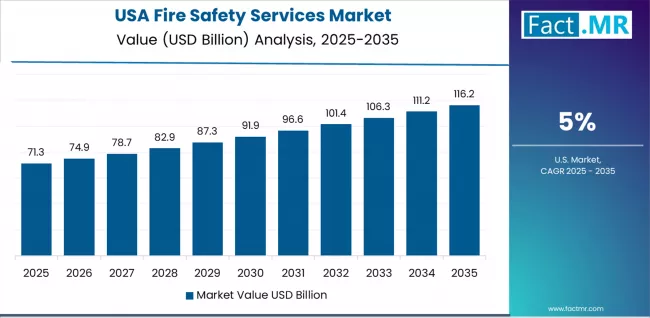
The fire safety services industry in the USA is projected to grow at a CAGR of 5.0% through 2035, making it the frontrunner in global industry expansion. The growth trajectory is supported by a thriving commercial construction sector, extensive government initiatives promoting safety modernization, and expanding building technology adoption. Rising investments in safety infrastructure and the integration of automated protection systems further strengthen market development.
The USA’s leadership stems from stringent NFPA fire codes, robust commercial real estate development, and the construction of data centers requiring advanced suppression systems. Additional factors include high insurance compliance standards, government buildings demanding enhanced protection, and the growing integration of fire systems within building automation networks. Expanding healthcare and institutional infrastructure also contribute significantly.
Government-backed modernization programs continue to stimulate demand for next-generation fire safety solutions. Construction hubs nationwide are rapidly adopting integrated technologies as building operators prioritize comprehensive safety capabilities and digitalized monitoring systems.
Why Is Mexico Emerging as a Hub for Construction and Fire Safety Advancement?
Revenue from fire safety services in Mexico is expected to rise at a CAGR of 4.7% through 2035, driven by accelerating construction activities and modernization initiatives. Expanding urban infrastructure, coupled with rising adoption of safety technologies, continues to enhance market potential. Increasing safety awareness and quality-control standards are encouraging widespread implementation of advanced protection systems.
Mexico’s growth momentum is reinforced by urbanization, foreign investment, and industrial development. The expanding commercial and manufacturing sectors demand robust fire protection, while government infrastructure projects and a booming tourism industry, particularly in hotel and resort construction, further elevate safety requirements. The growing middle class and maquiladora industries are also adopting global safety standards, creating consistent demand for fire protection systems.
Rising construction requirements and metropolitan expansion create fertile ground for innovation. Progressive developers are investing in smart safety facilities and integrated systems, particularly across major urban centers, thereby strengthening the country’s position as a regional construction and safety hub.
How Does Germany’s Engineering Expertise Drive Fire Safety Innovation?
The fire safety services market in Germany is forecast to grow at a CAGR of 4.5% through 2035, underpinned by the nation’s engineering excellence and sustained investment in technological advancement. Germany’s mature construction and industrial base provide fertile ground for adopting sophisticated safety solutions, while its commitment to innovation ensures continued leadership in fire protection technologies.
The country’s strong engineering heritage, world-class construction industry, and stringent building regulations contribute to its competitive edge. High-tech manufacturing, automotive facilities, and automation-driven infrastructure demand precision-engineered fire safety systems. Moreover, Germany’s advanced insurance sector and technical education standards reinforce the widespread adoption of reliable protection technologies.
Growing demand for high-performance safety systems drives continuous investment in research and quality-focused solutions. Sophisticated users increasingly prefer German-engineered platforms for their proven reliability, leading to strong domestic and international adoption across major construction regions.
What Is Driving France’s Focus on Building Modernization and Safety Integration?
In France, the demand for fire safety services is anticipated to increase at a CAGR of 4.2% through 2035, propelled by sustained investments in building modernization and safety system integration. The country’s expanding construction sector and strong policy support for technological upgrades are fostering a dynamic growth environment.
Key growth drivers include modernization programs, energy-efficient construction, and sustainability-focused initiatives. France’s nuclear facilities, healthcare institutions, and hospitality sectors demand advanced safety measures, while the government’s focus on infrastructure improvement encourages large-scale adoption of integrated fire safety systems. The nation’s leadership in materials research and building automation further strengthens its position in the European market.
Progressive construction enterprises are investing in advanced safety integration across urban regions. The increasing appeal of seamless safety platforms and high-efficiency systems enhances overall adoption, reinforcing France’s role as a leader in fire safety innovation and modernization.
How is the UK Advancing Safety Technology and Building Innovation?
The fire safety services landscape in the UK is projected to grow at a CAGR of 4.1% through 2035, supported by the country’s leadership in safety technology development and building innovation. A mature construction industry, strong R&D capabilities, and government-backed reforms following key safety incidents have spurred continuous improvement across the sector.
The UK’s growth is anchored by stringent building regulations, government safety initiatives, and a thriving construction ecosystem. Sectors such as financial services, healthcare, and residential housing drive sustained demand for specialized fire protection systems. Emphasis on building performance, automation, and fire resilience continues to shape market dynamics.
The nation’s focus on integrated safety technologies and smart construction enables advanced system adoption across both domestic and export-oriented projects. Enhanced safety management frameworks and modernized construction practices ensure the UK’s continued advancement in global fire protection standards.
How is South Korea Integrating Technology to Strengthen Its Fire Safety Landscape?
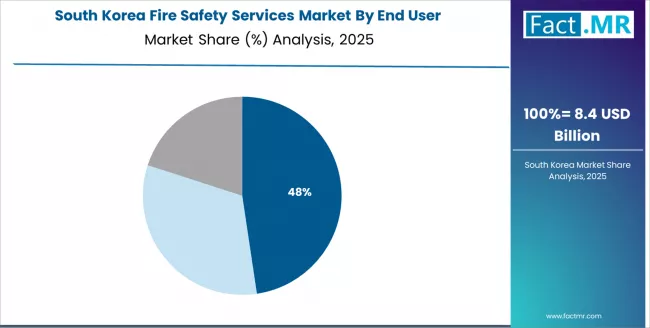
The market for fire safety services in South Korea is expected to expand at a CAGR of 4.0% through 2035, driven by the integration of cutting-edge technologies and rapid construction sector modernization. The country’s commitment to smart building infrastructure and safety digitization continues to attract strong investment.
South Korea’s construction, shipbuilding, and semiconductor industries are major consumers of advanced fire safety systems. Government-led smart city projects and strong adoption of automation technologies have positioned the country as a regional technology leader. Rising demand from automotive and electronics manufacturing further enhances growth prospects.
Continuous innovation in safety platforms and system integration underpins market development. Advanced, technology-driven fire safety solutions are being rapidly adopted by construction enterprises nationwide, creating a highly connected, intelligent safety ecosystem.
Why is Japan Prioritizing Quality Control and Technology-Driven Construction?
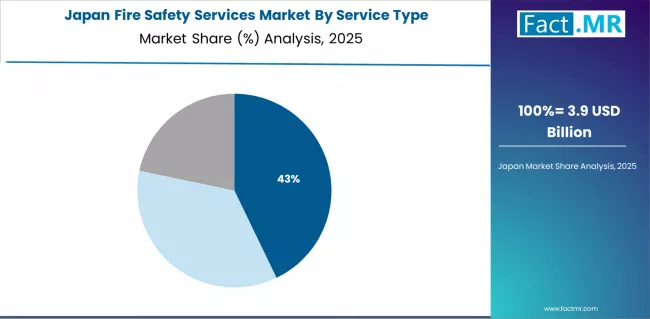
Demand for fire safety services in Japan is forecast to grow at a CAGR of 3.8% through 2035, supported by the nation’s deep-rooted culture of quality control and precision engineering. Japan’s emphasis on disaster resilience, seismic safety, and technological innovation continues to define its construction and safety ecosystem.
Growth drivers include the country’s highly sophisticated building industry, focus on earthquake-resistant structures, and strong demand from the electronics, automotive, and manufacturing sectors for specialized fire suppression systems. Continuous advancements in fire-resistant materials and building automation technologies enhance Japan’s safety standards further.
Rising adoption of integrated and high-quality safety systems reinforces Japan’s leadership in precision-driven construction. The country’s ability to merge technological innovation with stringent safety compliance continues to attract investment in advanced protection platforms.
How is Europe Strengthening Its Fire Safety Landscape Across Key Countries?
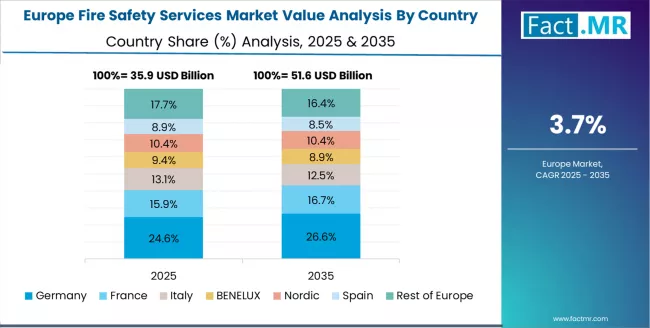
The fire safety services market in Europe is projected to expand from USD 46.7 billion in 2025 to USD 69.8 billion by 2035, reflecting a steady CAGR of 4.3% during the forecast period. Germany is expected to maintain its leadership position, accounting for 33.1% of the regional market in 2025, with a marginal increase to 33.4% by 2035.
Growth is driven by the nation’s strong engineering culture, sophisticated safety manufacturing capabilities, and a mature construction ecosystem serving diverse commercial and industrial applications across the continent.
France follows with a 25.9% share in 2025, projected to reach 26.2% by 2035. Rising demand for advanced fire safety technologies, coupled with government-led modernization programs and robust construction infrastructure, continues to bolster market development. The country’s expertise in integrating safety technologies into building systems further enhances its competitive standing.
The UK holds a 21.8% market share in 2025, expected to edge up to 22.0% by 2035. Expansion is supported by the country’s thriving safety technology sector, an increase in residential and commercial construction, and stronger regulatory focus on building safety innovation. Italy commands an 11.5% share in 2025, projected to rise slightly to 11.7% by 2035, supported by infrastructure modernization and rising public sector investments in fire safety upgrades.
Spain accounts for 6.2% of the regional share in 2025, expected to grow to 6.3% by 2035, driven by urban redevelopment projects and increasing adoption of fire safety systems across commercial buildings. The rest of Europe is anticipated to maintain steady progress, with collective market share adjusting from 1.5% in 2025 to 0.4% by 2035.
Competitive Landscape of the Fire Safety Services Market
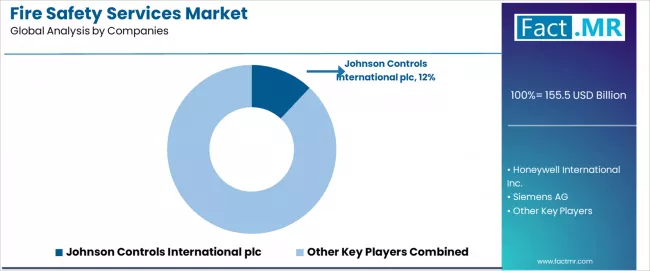
The fire safety services market demonstrates intense competition among established building services companies, specialized fire protection providers, and integrated safety solution suppliers. Companies invest heavily in technology development, service expansion, and comprehensive technical capabilities to deliver reliable, effective, and code-compliant fire safety solutions. Innovation in smart detection systems, IoT integration, and predictive maintenance remains central to strengthening market position and competitive advantage across global markets.
Johnson Controls International Plc. leads the market with a substantial 12.0% market share, offering comprehensive fire safety solutions including quality building platforms and advanced detection systems with particular focus on commercial and industrial applications. The company's strength lies in building automation innovation, providing integrated solutions that combine fire safety with building management systems.
Honeywell International Inc. provides specialized safety capabilities with strong emphasis on advanced fire detection implementations and intelligent building solutions, particularly serving commercial and industrial markets. Siemens delivers comprehensive building services with focus on integrated platforms and large-scale construction applications, combining fire safety with building automation technologies.
UTC Climate specializes in advanced HVAC and fire protection systems for building applications, expanding market reach through comprehensive building solutions. Allegion focuses on building security and fire safety integration with innovative access control solutions. Tyco offers advanced fire protection platforms with emphasis on detection and suppression systems, serving both commercial and industrial sectors. The competitive environment also includes significant players like Schneider Electric, Chubb, Securitas, and ADT Inc., each focusing on specific market segments and technological specializations in fire safety and building security.
The competitive landscape reflects ongoing consolidation as larger building services companies acquire specialized fire safety providers to expand their service portfolios and market reach. Companies focus on developing integrated solutions that combine fire safety technology with building automation systems, predictive analytics, and remote monitoring capabilities to differentiate offerings and capture higher-value market segments.
Strategic partnerships between fire safety providers and building operators drive innovation and market expansion, while increasing emphasis on smart buildings creates opportunities for technology leaders to develop more sophisticated safety solutions integrated with IoT platforms and artificial intelligence.
Key Players in the Fire Safety Services Market
- Johnson Controls International plc
- Honeywell International Inc.
- Siemens AG
- Carrier Global Corporation (formerly UTC Climate, Controls & Security)
- Allegion plc
- Tyco Fire & Security (a subsidiary of Johnson Controls)
- Schneider Electric SE
- Chubb Fire & Security Ltd.
- Securitas AB
- ADT Inc.
Scope of the Report
| Item | Value |
|---|---|
| Quantitative Units | USD 155.5 Billion |
| Service Type | Fire alarm monitoring; Sprinkler installation; Inspection & maintenance |
| End User | Commercial; Industrial; Residential |
| Region | North America; Europe; Asia-Pacific |
| Regions Covered | North America; Europe; Asia-Pacific; Latin America; Middle East & Africa |
| Countries Covered | USA; Germany; France; UK; Japan; South Korea; Mexico; and 40+ additional countries |
| Key Companies Profiled | Johnson Controls; Honeywell; Siemens; UTC Climate; Allegion; Tyco |
| Additional Attributes | Dollar sales by service type and end user category; regional demand trends; competitive landscape; technological advancements in fire protection; smart building development; safety compliance innovation; building protection optimization |
Fire Safety Services Market by Segments
-
Service Type :
- Fire Alarm Monitoring
- Sprinkler Installation
- Inspection & Maintenance
-
End User :
- Commercial
- Industrial
- Residential
-
Region :
- North America
- Europe
- Asia-Pacific
-
Regional Coverage :
- North America
- USA
- Canada
- Mexico
- Europe
- Germany
- UK
- France
- Italy
- Spain
- Rest of Europe
- Asia-Pacific
- China
- Japan
- South Korea
- India
- Australia
- Rest of Asia-Pacific
- Latin America
- Brazil
- Argentina
- Rest of Latin America
- Middle East & Africa
- Saudi Arabia
- UAE
- South Africa
- Rest of Middle East & Africa
- North America
Table of Content
- Executive Summary
- Global Market Outlook
- Demand to side Trends
- Supply to side Trends
- Technology Roadmap Analysis
- Analysis and Recommendations
- Market Overview
- Market Coverage / Taxonomy
- Market Definition / Scope / Limitations
- Market Background
- Market Dynamics
- Drivers
- Restraints
- Opportunity
- Trends
- Scenario Forecast
- Demand in Optimistic Scenario
- Demand in Likely Scenario
- Demand in Conservative Scenario
- Opportunity Map Analysis
- Product Life Cycle Analysis
- Supply Chain Analysis
- Investment Feasibility Matrix
- Value Chain Analysis
- PESTLE and Porter’s Analysis
- Regulatory Landscape
- Regional Parent Market Outlook
- Production and Consumption Statistics
- Import and Export Statistics
- Market Dynamics
- Global Market Analysis 2020 to 2024 and Forecast, 2025 to 2035
- Historical Market Size Value (USD Million) Analysis, 2020 to 2024
- Current and Future Market Size Value (USD Million) Projections, 2025 to 2035
- Y to o to Y Growth Trend Analysis
- Absolute $ Opportunity Analysis
- Global Market Pricing Analysis 2020 to 2024 and Forecast 2025 to 2035
- Global Market Analysis 2020 to 2024 and Forecast 2025 to 2035, By Service Type
- Introduction / Key Findings
- Historical Market Size Value (USD Million) Analysis By Service Type , 2020 to 2024
- Current and Future Market Size Value (USD Million) Analysis and Forecast By Service Type , 2025 to 2035
- Fire Alarm Monitoring
- Sprinkler Installation
- Inspection & Maintenance
- Y to o to Y Growth Trend Analysis By Service Type , 2020 to 2024
- Absolute $ Opportunity Analysis By Service Type , 2025 to 2035
- Global Market Analysis 2020 to 2024 and Forecast 2025 to 2035, By End User
- Introduction / Key Findings
- Historical Market Size Value (USD Million) Analysis By End User, 2020 to 2024
- Current and Future Market Size Value (USD Million) Analysis and Forecast By End User, 2025 to 2035
- Commercial
- Industrial
- Residential
- Y to o to Y Growth Trend Analysis By End User, 2020 to 2024
- Absolute $ Opportunity Analysis By End User, 2025 to 2035
- Global Market Analysis 2020 to 2024 and Forecast 2025 to 2035, By Region
- Introduction
- Historical Market Size Value (USD Million) Analysis By Region, 2020 to 2024
- Current Market Size Value (USD Million) Analysis and Forecast By Region, 2025 to 2035
- North America
- Latin America
- Western Europe
- Eastern Europe
- East Asia
- South Asia and Pacific
- Middle East & Africa
- Market Attractiveness Analysis By Region
- North America Market Analysis 2020 to 2024 and Forecast 2025 to 2035, By Country
- Historical Market Size Value (USD Million) Trend Analysis By Market Taxonomy, 2020 to 2024
- Market Size Value (USD Million) Forecast By Market Taxonomy, 2025 to 2035
- By Country
- USA
- Canada
- Mexico
- By Service Type
- By End User
- By Country
- Market Attractiveness Analysis
- By Country
- By Service Type
- By End User
- Key Takeaways
- Latin America Market Analysis 2020 to 2024 and Forecast 2025 to 2035, By Country
- Historical Market Size Value (USD Million) Trend Analysis By Market Taxonomy, 2020 to 2024
- Market Size Value (USD Million) Forecast By Market Taxonomy, 2025 to 2035
- By Country
- Brazil
- Chile
- Rest of Latin America
- By Service Type
- By End User
- By Country
- Market Attractiveness Analysis
- By Country
- By Service Type
- By End User
- Key Takeaways
- Western Europe Market Analysis 2020 to 2024 and Forecast 2025 to 2035, By Country
- Historical Market Size Value (USD Million) Trend Analysis By Market Taxonomy, 2020 to 2024
- Market Size Value (USD Million) Forecast By Market Taxonomy, 2025 to 2035
- By Country
- Germany
- UK
- Italy
- Spain
- France
- Nordic
- BENELUX
- Rest of Western Europe
- By Service Type
- By End User
- By Country
- Market Attractiveness Analysis
- By Country
- By Service Type
- By End User
- Key Takeaways
- Eastern Europe Market Analysis 2020 to 2024 and Forecast 2025 to 2035, By Country
- Historical Market Size Value (USD Million) Trend Analysis By Market Taxonomy, 2020 to 2024
- Market Size Value (USD Million) Forecast By Market Taxonomy, 2025 to 2035
- By Country
- Russia
- Poland
- Hungary
- Balkan & Baltic
- Rest of Eastern Europe
- By Service Type
- By End User
- By Country
- Market Attractiveness Analysis
- By Country
- By Service Type
- By End User
- Key Takeaways
- East Asia Market Analysis 2020 to 2024 and Forecast 2025 to 2035, By Country
- Historical Market Size Value (USD Million) Trend Analysis By Market Taxonomy, 2020 to 2024
- Market Size Value (USD Million) Forecast By Market Taxonomy, 2025 to 2035
- By Country
- China
- Japan
- South Korea
- By Service Type
- By End User
- By Country
- Market Attractiveness Analysis
- By Country
- By Service Type
- By End User
- Key Takeaways
- South Asia and Pacific Market Analysis 2020 to 2024 and Forecast 2025 to 2035, By Country
- Historical Market Size Value (USD Million) Trend Analysis By Market Taxonomy, 2020 to 2024
- Market Size Value (USD Million) Forecast By Market Taxonomy, 2025 to 2035
- By Country
- India
- ASEAN
- Australia & New Zealand
- Rest of South Asia and Pacific
- By Service Type
- By End User
- By Country
- Market Attractiveness Analysis
- By Country
- By Service Type
- By End User
- Key Takeaways
- Middle East & Africa Market Analysis 2020 to 2024 and Forecast 2025 to 2035, By Country
- Historical Market Size Value (USD Million) Trend Analysis By Market Taxonomy, 2020 to 2024
- Market Size Value (USD Million) Forecast By Market Taxonomy, 2025 to 2035
- By Country
- Kingdom of Saudi Arabia
- Other GCC Countries
- Turkiye
- South Africa
- Other African Union
- Rest of Middle East & Africa
- By Service Type
- By End User
- By Country
- Market Attractiveness Analysis
- By Country
- By Service Type
- By End User
- Key Takeaways
- Key Countries Market Analysis
- USA
- Pricing Analysis
- Market Share Analysis, 2024
- By Service Type
- By End User
- Canada
- Pricing Analysis
- Market Share Analysis, 2024
- By Service Type
- By End User
- Mexico
- Pricing Analysis
- Market Share Analysis, 2024
- By Service Type
- By End User
- Brazil
- Pricing Analysis
- Market Share Analysis, 2024
- By Service Type
- By End User
- Chile
- Pricing Analysis
- Market Share Analysis, 2024
- By Service Type
- By End User
- Germany
- Pricing Analysis
- Market Share Analysis, 2024
- By Service Type
- By End User
- UK
- Pricing Analysis
- Market Share Analysis, 2024
- By Service Type
- By End User
- Italy
- Pricing Analysis
- Market Share Analysis, 2024
- By Service Type
- By End User
- Spain
- Pricing Analysis
- Market Share Analysis, 2024
- By Service Type
- By End User
- France
- Pricing Analysis
- Market Share Analysis, 2024
- By Service Type
- By End User
- India
- Pricing Analysis
- Market Share Analysis, 2024
- By Service Type
- By End User
- ASEAN
- Pricing Analysis
- Market Share Analysis, 2024
- By Service Type
- By End User
- Australia & New Zealand
- Pricing Analysis
- Market Share Analysis, 2024
- By Service Type
- By End User
- China
- Pricing Analysis
- Market Share Analysis, 2024
- By Service Type
- By End User
- Japan
- Pricing Analysis
- Market Share Analysis, 2024
- By Service Type
- By End User
- South Korea
- Pricing Analysis
- Market Share Analysis, 2024
- By Service Type
- By End User
- Russia
- Pricing Analysis
- Market Share Analysis, 2024
- By Service Type
- By End User
- Poland
- Pricing Analysis
- Market Share Analysis, 2024
- By Service Type
- By End User
- Hungary
- Pricing Analysis
- Market Share Analysis, 2024
- By Service Type
- By End User
- Kingdom of Saudi Arabia
- Pricing Analysis
- Market Share Analysis, 2024
- By Service Type
- By End User
- Turkiye
- Pricing Analysis
- Market Share Analysis, 2024
- By Service Type
- By End User
- South Africa
- Pricing Analysis
- Market Share Analysis, 2024
- By Service Type
- By End User
- USA
- Market Structure Analysis
- Competition Dashboard
- Competition Benchmarking
- Market Share Analysis of Top Players
- By Regional
- By Service Type
- By End User
- Competition Analysis
- Competition Deep Dive
- Johnson Controls International plc
- Overview
- Product Portfolio
- Profitability by Market Segments (Product/Age /Sales Channel/Region)
- Sales Footprint
- Strategy Overview
- Marketing Strategy
- Product Strategy
- Channel Strategy
- Honeywell International Inc.
- Siemens AG
- Carrier Global Corporation (formerly UTC Climate, Controls & Security)
- Allegion plc
- Tyco Fire & Security (a subsidiary of Johnson Controls)
- Schneider Electric SE
- Chubb Fire & Security Ltd.
- Securitas AB
- ADT Inc.
- Johnson Controls International plc
- Competition Deep Dive
- Assumptions & Acronyms Used
- Research Methodology
List Of Table
- Table 1: Global Market Value (USD Million) Forecast by Region, 2020 to 2035
- Table 2: Global Market Value (USD Million) Forecast by Service Type , 2020 to 2035
- Table 3: Global Market Value (USD Million) Forecast by End User, 2020 to 2035
- Table 4: North America Market Value (USD Million) Forecast by Country, 2020 to 2035
- Table 5: North America Market Value (USD Million) Forecast by Service Type , 2020 to 2035
- Table 6: North America Market Value (USD Million) Forecast by End User, 2020 to 2035
- Table 7: Latin America Market Value (USD Million) Forecast by Country, 2020 to 2035
- Table 8: Latin America Market Value (USD Million) Forecast by Service Type , 2020 to 2035
- Table 9: Latin America Market Value (USD Million) Forecast by End User, 2020 to 2035
- Table 10: Western Europe Market Value (USD Million) Forecast by Country, 2020 to 2035
- Table 11: Western Europe Market Value (USD Million) Forecast by Service Type , 2020 to 2035
- Table 12: Western Europe Market Value (USD Million) Forecast by End User, 2020 to 2035
- Table 13: Eastern Europe Market Value (USD Million) Forecast by Country, 2020 to 2035
- Table 14: Eastern Europe Market Value (USD Million) Forecast by Service Type , 2020 to 2035
- Table 15: Eastern Europe Market Value (USD Million) Forecast by End User, 2020 to 2035
- Table 16: East Asia Market Value (USD Million) Forecast by Country, 2020 to 2035
- Table 17: East Asia Market Value (USD Million) Forecast by Service Type , 2020 to 2035
- Table 18: East Asia Market Value (USD Million) Forecast by End User, 2020 to 2035
- Table 19: South Asia and Pacific Market Value (USD Million) Forecast by Country, 2020 to 2035
- Table 20: South Asia and Pacific Market Value (USD Million) Forecast by Service Type , 2020 to 2035
- Table 21: South Asia and Pacific Market Value (USD Million) Forecast by End User, 2020 to 2035
- Table 22: Middle East & Africa Market Value (USD Million) Forecast by Country, 2020 to 2035
- Table 23: Middle East & Africa Market Value (USD Million) Forecast by Service Type , 2020 to 2035
- Table 24: Middle East & Africa Market Value (USD Million) Forecast by End User , 2020 to 2035
List Of Figures
- Figure 1: Global Market Pricing Analysis
- Figure 2: Global Market Value (USD Million) Forecast 2020-2035
- Figure 3: Global Market Value Share and BPS Analysis by Service Type , 2025 and 2035
- Figure 4: Global Market Y to o to Y Growth Comparison by Service Type , 2025-2035
- Figure 5: Global Market Attractiveness Analysis by Service Type
- Figure 6: Global Market Value Share and BPS Analysis by End User, 2025 and 2035
- Figure 7: Global Market Y to o to Y Growth Comparison by End User, 2025-2035
- Figure 8: Global Market Attractiveness Analysis by End User
- Figure 9: Global Market Value (USD Million) Share and BPS Analysis by Region, 2025 and 2035
- Figure 10: Global Market Y to o to Y Growth Comparison by Region, 2025-2035
- Figure 11: Global Market Attractiveness Analysis by Region
- Figure 12: North America Market Incremental Dollar Opportunity, 2025-2035
- Figure 13: Latin America Market Incremental Dollar Opportunity, 2025-2035
- Figure 14: Western Europe Market Incremental Dollar Opportunity, 2025-2035
- Figure 15: Eastern Europe Market Incremental Dollar Opportunity, 2025-2035
- Figure 16: East Asia Market Incremental Dollar Opportunity, 2025-2035
- Figure 17: South Asia and Pacific Market Incremental Dollar Opportunity, 2025-2035
- Figure 18: Middle East & Africa Market Incremental Dollar Opportunity, 2025-2035
- Figure 19: North America Market Value Share and BPS Analysis by Country, 2025 and 2035
- Figure 20: North America Market Value Share and BPS Analysis by Service Type , 2025 and 2035
- Figure 21: North America Market Y to o to Y Growth Comparison by Service Type , 2025-2035
- Figure 22: North America Market Attractiveness Analysis by Service Type
- Figure 23: North America Market Value Share and BPS Analysis by End User, 2025 and 2035
- Figure 24: North America Market Y to o to Y Growth Comparison by End User, 2025-2035
- Figure 25: North America Market Attractiveness Analysis by End User
- Figure 26: Latin America Market Value Share and BPS Analysis by Country, 2025 and 2035
- Figure 27: Latin America Market Value Share and BPS Analysis by Service Type , 2025 and 2035
- Figure 28: Latin America Market Y to o to Y Growth Comparison by Service Type , 2025-2035
- Figure 29: Latin America Market Attractiveness Analysis by Service Type
- Figure 30: Latin America Market Value Share and BPS Analysis by End User, 2025 and 2035
- Figure 31: Latin America Market Y to o to Y Growth Comparison by End User, 2025-2035
- Figure 32: Latin America Market Attractiveness Analysis by End User
- Figure 33: Western Europe Market Value Share and BPS Analysis by Country, 2025 and 2035
- Figure 34: Western Europe Market Value Share and BPS Analysis by Service Type , 2025 and 2035
- Figure 35: Western Europe Market Y to o to Y Growth Comparison by Service Type , 2025-2035
- Figure 36: Western Europe Market Attractiveness Analysis by Service Type
- Figure 37: Western Europe Market Value Share and BPS Analysis by End User, 2025 and 2035
- Figure 38: Western Europe Market Y to o to Y Growth Comparison by End User, 2025-2035
- Figure 39: Western Europe Market Attractiveness Analysis by End User
- Figure 40: Eastern Europe Market Value Share and BPS Analysis by Country, 2025 and 2035
- Figure 41: Eastern Europe Market Value Share and BPS Analysis by Service Type , 2025 and 2035
- Figure 42: Eastern Europe Market Y to o to Y Growth Comparison by Service Type , 2025-2035
- Figure 43: Eastern Europe Market Attractiveness Analysis by Service Type
- Figure 44: Eastern Europe Market Value Share and BPS Analysis by End User, 2025 and 2035
- Figure 45: Eastern Europe Market Y to o to Y Growth Comparison by End User, 2025-2035
- Figure 46: Eastern Europe Market Attractiveness Analysis by End User
- Figure 47: East Asia Market Value Share and BPS Analysis by Country, 2025 and 2035
- Figure 48: East Asia Market Value Share and BPS Analysis by Service Type , 2025 and 2035
- Figure 49: East Asia Market Y to o to Y Growth Comparison by Service Type , 2025-2035
- Figure 50: East Asia Market Attractiveness Analysis by Service Type
- Figure 51: East Asia Market Value Share and BPS Analysis by End User, 2025 and 2035
- Figure 52: East Asia Market Y to o to Y Growth Comparison by End User, 2025-2035
- Figure 53: East Asia Market Attractiveness Analysis by End User
- Figure 54: South Asia and Pacific Market Value Share and BPS Analysis by Country, 2025 and 2035
- Figure 55: South Asia and Pacific Market Value Share and BPS Analysis by Service Type , 2025 and 2035
- Figure 56: South Asia and Pacific Market Y to o to Y Growth Comparison by Service Type , 2025-2035
- Figure 57: South Asia and Pacific Market Attractiveness Analysis by Service Type
- Figure 58: South Asia and Pacific Market Value Share and BPS Analysis by End User, 2025 and 2035
- Figure 59: South Asia and Pacific Market Y to o to Y Growth Comparison by End User, 2025-2035
- Figure 60: South Asia and Pacific Market Attractiveness Analysis by End User
- Figure 61: Middle East & Africa Market Value Share and BPS Analysis by Country, 2025 and 2035
- Figure 62: Middle East & Africa Market Value Share and BPS Analysis by Service Type , 2025 and 2035
- Figure 63: Middle East & Africa Market Y to o to Y Growth Comparison by Service Type , 2025-2035
- Figure 64: Middle East & Africa Market Attractiveness Analysis by Service Type
- Figure 65: Middle East & Africa Market Value Share and BPS Analysis by End User, 2025 and 2035
- Figure 66: Middle East & Africa Market Y to o to Y Growth Comparison by End User, 2025-2035
- Figure 67: Middle East & Africa Market Attractiveness Analysis by End User
- Figure 68: Global Market - Tier Structure Analysis
- Figure 69: Global Market - Company Share Analysis
- FAQs -
How big is the fire safety services market in 2025?
The global fire safety services market is estimated to be valued at USD 155.5 billion in 2025.
What will be the size of fire safety services market in 2035?
The market size for the fire safety services market is projected to reach USD 232.5 billion by 2035.
How much will be the fire safety services market growth between 2025 and 2035?
The fire safety services market is expected to grow at a 4.1% CAGR between 2025 and 2035.
What are the key product types in the fire safety services market?
The key product types in fire safety services market are fire alarm monitoring, sprinkler installation and inspection & maintenance.
Which end user segment to contribute significant share in the fire safety services market in 2025?
In terms of end user, commercial segment to command 50.0% share in the fire safety services market in 2025.